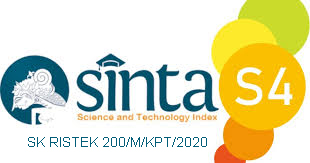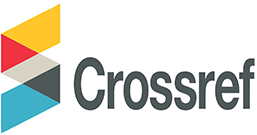Assessment of Employee Using Simple Multi-Attribute Technique Exploiting Rank (SMARTER) and Behaviorally Anchor Rating Scale (BARS) Method
Abstract
Lecturers' active role as the spearhead of higher education has an essential role in improving higher education quality and sustainability. Therefore, assessing work behaviour is needed to measure how lecturers participate in achieving the vision and mission, quality improvement, and service guarantee to students and complementary documentation. This condition became the basis of research. They are implementing decision support systems with Simple Multi-Attribute Rating Technique Exploiting Ranges (SMARTER) and Graphic Rating Scale (GRS) to measure a lecturer's behaviour by using multiple criteria. With the SMARTER method and Behaviorally Anchor Rating Scale (BARS). By applying the impermeable BARS method, the work behaviour assessment process results in ease and accuracy that is more in line with the employees' behaviour being assessed. With the SMARTER approach, an assessment of employee work behaviour is produced, with 90% of alternatives used. The results are Good.
Keywords
Full Text:
PDFReferences
Dessler, G. (2013). Human Resource Management , 13th Edition. London: Pearson Prentice Hall Inc.
Dewi, M. A., Murad, D. F., & Rosdiana. (2019). Implementation Of The Smart Models For Application Development Employee Performance Appraisal. International Conference on Sustainable Information Engineering and Technology (SIET) (pp. 364-269). Lombok, Indonesia: IEEE.
Edward, W., & F.Hutton, B. (1994). Edwards, W. And Barron, F.H. Smarts And Smarter: Improved Simple Methods For Multi Attribute Utility Measurement, Organizational Behaviour And Human Decision Process, 1994. Organizational Behavior and Human Decision Processes, 306-325.
Evita, S., Zusnita Muizu, W., & Atmojo, R. (2017). Employee Performance Appraisal Using Behaviorally Anchor Rating Scale Methods And Management By Objectives (Case Study at PT Qwords Company International). Pebkis Jurnal, 18-32.
Han, J., & Kamber, M. (2000). Data Mining : Concepts and Techniques. San Fransisco: Morgan Kaufmann Publishers.
Haryanti, D., Nasution, H., & Sukamto, A. S. (2016). Dwi Haryanti, Helfi Nasution, Anggi Srimurdianti S. Decision Support System for Admission of Bidikmisi Full Scholarship Replacement Students at Tanjungpura University by Applying the Smarter Method. Journal of Information Technology and Systems, 1-7.
Hollenbeck, J., Noe, R., Wright, P., & Gerhart, B. (2012). Human Resource Management. In J. Hollenbeck, R. Noe, P. Wright, & B. Gerhart, Human Resource Management Gaining Competitive Advantage. Boston: McGraw-Hill Education.
Martin-Raugh, M., Tannenbaum, R., Tocci, C., & Reese, C. (2016). Behaviorally anchored rating scales: An application for evaluating. Teaching and Teacher Education, 414-419.
Morais, D., & Schramm, F. (2012). Decision Support Model for Selecting and Evaluating Suppliers in the Construction Industry. Pesquisa Operacional, 643-662.
Saleh, A., Puspita, K., Sanjaya, A., Daifiria, & Giovani. (2018). Implementation of Equal Width Interval Discretization on SMARTER Method for Selecting mputer Laboratory Assistant . International Conference on Cyber and IT Service Management (CITSM 2018) (pp. 1-4). Medan: IEEE.
Schwab, D., Heneman III, H., & DeCOTIIS, T. (2006). Behaviorally Anchored Rating Scales: A Review Of The Literature . Personnel Psychology, 549-562.
Sevima. (2017, Juny 12). Sevima. Retrieved from Sentra Vidya Utama: https://sevima.com/pentingnya-evaluasi-kinerja-dosen/
Siregar, D., Arisandi, D., Usman, A., & Irwan, D. (2017). Research Of Simple Multi-Attribute Rating Technique For Decision Support. Journal of Phisics Conference Series, 1-6.
Turban, E., Aronson, J., & Liang, T.-P. (2005). DECISION support systems and intelligent systems. In D. Prabatini, sistem pendukung keputusan dan sistem cerdas. Yogyakarta: Andi Offset.
Vance, R., Kuhnert, K., & Farr, J. (1978). Interview judgments: Using external criteria to compare behavioral and graphic scale ratings. Organizational Behavioral and Human Performance, 279-294.
W.S, W. (1995). Psychology of Performance Appraisal. Jakarta: Gramedia.
Wardhana, A., & Betrianis. (2006). Supply Chain Management Performance Assessment Using Fuzzy Set Theory Method and Typical Performance Measurement Method,. Jurnal of Technology, 221-229.
DOI: https://doi.org/10.31326/jisa.v4i2.944
Refbacks
- There are currently no refbacks.
Copyright (c) 2021 Heni Sulastri

This work is licensed under a Creative Commons Attribution-ShareAlike 4.0 International License.
JOURNAL IDENTITY
Journal Name: JISA (Jurnal Informatika dan Sains)
e-ISSN: 2614-8404, p-ISSN: 2776-3234
Publisher: Program Studi Teknik Informatika Universitas Trilogi
Publication Schedule: June and December
Language: Indonesia & English
APC: The Journal Charges Fees for Publishing
Indexing: EBSCO , DOAJ, Google Scholar, Arsip Relawan Jurnal Indonesia, Directory of Research Journals Indexing, Index Copernicus International, PKP Index, Science and Technology Index (SINTA, S4) , Garuda Index
OAI address: http://trilogi.ac.id/journal/ks/index.php/JISA/oai
Contact: jisa@trilogi.ac.id
Sponsored by: DOI – Digital Object Identifier Crossref, Universitas Trilogi
In Collaboration With: Indonesian Artificial Intelligent Ecosystem(IAIE), Relawan Jurnal Indonesia, Jurnal Teknologi dan Sistem Komputer (JTSiskom)
JISA (Jurnal Informatika dan Sains) is Published by Program Studi Teknik Informatika, Universitas Trilogi under Creative Commons Attribution-ShareAlike 4.0 International License.


















